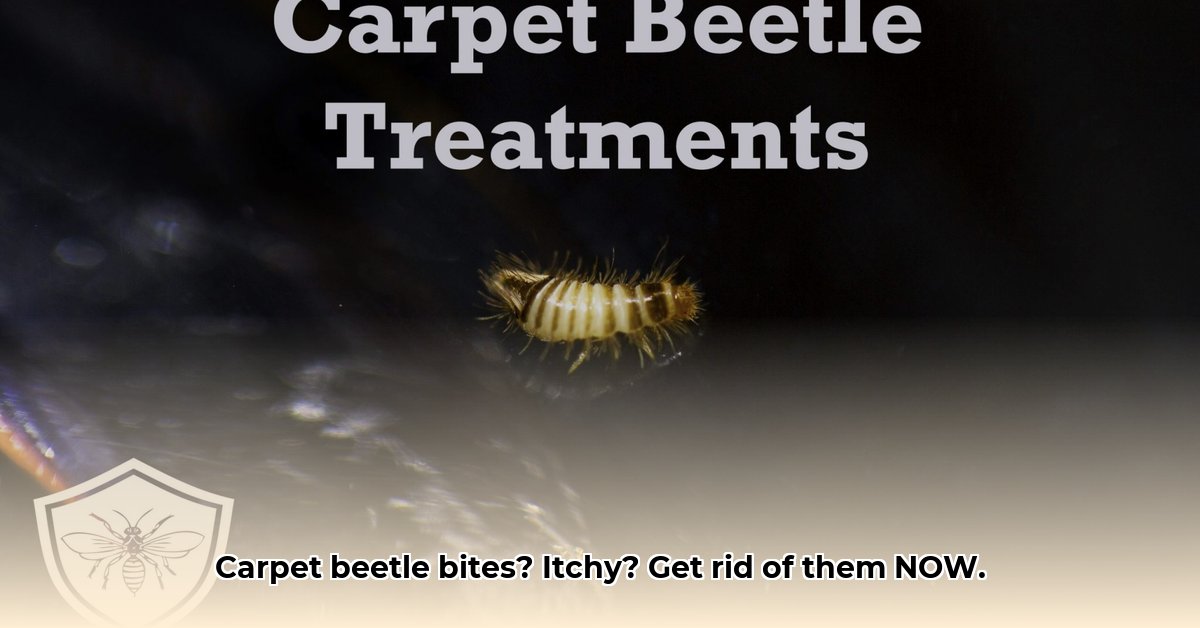Itchy, red bumps have you convinced you’re covered in carpet beetle bites? Think again. Carpet beetles don’t bite. The real culprit is an allergic reaction to the microscopic, barbed hairs (setae) and shed skin of their larvae. This guide provides a clear, step-by-step approach to soothing your skin and eliminating these pesky insects.
Decoding the Itch: Carpet Beetle Larvae Allergy
Those irritating bumps? They’re probably an allergic reaction, not bites. The problem stems from the tiny, barbed hairs (setae) found on carpet beetle larvae. These larvae, the immature, worm-like stage of the beetle, shed these setae, which can become airborne, land on your skin, or get trapped in fabrics. Your skin reacts to these bristles, causing a red, itchy rash often mistaken for insect bites. Some individuals may also react to the shed larval casings themselves, which can accumulate in carpets and furniture, amplifying the allergic reaction.
Identifying the Culprit: Carpet Beetle Larvae
Carpet beetle larvae resemble small, fuzzy or bristly worms, often brownish in color. They prefer dark, undisturbed areas like carpets, rugs, closets, and stored fabrics. Adult carpet beetles are small, round, and often have distinct patterns on their wings. While the adults themselves are harmless, their larval offspring are the source of the skin irritation.
Recognizing the Rash: Symptoms of a Carpet Beetle Larvae Allergy
A carpet beetle larvae allergy typically manifests as small, red, itchy welts, often appearing in clusters or lines, following the larvae’s crawling path. These welts may resemble mosquito bites or hives and can be accompanied by a burning sensation. In more severe cases, blisters may develop. The rash typically appears on exposed skin such as arms, legs, neck, and face.
Soothing the Itch: Treating the Reaction
Here’s a step-by-step guide to relieving the itch:
- Cleanse: Gently wash the affected area with mild soap and lukewarm water to remove any lingering setae.
- Cool: Apply a cool compress for 15-20 minutes, several times a day, to reduce inflammation.
- Over-the-Counter Relief: Oral antihistamines (like diphenhydramine or cetirizine) can help manage the allergic reaction. Topical hydrocortisone cream can also provide relief. An oatmeal bath can also be very effective.
- Resist the Scratch: Avoid scratching, as it can worsen the irritation and increase the risk of infection.
- Seek Medical Advice: Consult a doctor or dermatologist if the rash is severe, persists, or shows signs of infection.
Evicting the Invaders: Getting Rid of Carpet Beetles
Here’s how to eliminate carpet beetles:
- Deep Clean: Thoroughly vacuum carpets, rugs, upholstered furniture, cracks, and crevices. Empty the vacuum bag or canister immediately and dispose of it outside.
- Launder: Wash all bedding, clothing, and other washable fabrics in hot water and dry on high heat. Consider dry cleaning non-washable items.
- Insecticide (Use with Caution): For persistent infestations, consider using an insecticide specifically designed for carpet beetles, following all safety precautions. Natural alternatives like diatomaceous earth can also be considered.
- Professional Help: For severe infestations, contact a qualified pest control professional.
Preventing Future Infestations
Here’s how to keep carpet beetles at bay:
- Regular Cleaning: Frequent vacuuming and laundering are crucial.
- Proper Storage: Store susceptible items (wool, fur, feathers, silk) in airtight containers. Using cedar chips, lavender sachets, or other natural insect repellents can add extra protection. Regular airing of these stored items is also recommended.
- Declutter: Reducing clutter minimizes potential hiding places.
- Seal Cracks and Crevices: This limits entry points for beetles.
- Inspect Secondhand Items: Carefully check used furniture, clothing, and rugs before bringing them into your home.
Carpet Beetle Rash vs. Other Skin Irritations
| Feature | Carpet Beetle Rash | Bed Bug Bites | Other Allergies (e.g., dust mites) |
|---|---|---|---|
| Cause | Allergic reaction to larval hairs and shed skins | Bites from bed bugs | Immune response to allergen |
| Appearance | Red, itchy welts, often in clusters or lines | Small, red bumps, often in a row or a zigzag pattern, often found on skin exposed while sleeping | Varies, can include hives, itching, redness |
| Location | Primarily on exposed skin | Often clustered around mattress seams, bedding, or furniture | Can occur anywhere on the body |
| Itching | Varies in intensity | Often intense, persistent | Varies in intensity |
Frequently Asked Questions
- Are carpet beetle “bites” dangerous? Generally, no. While the itching can be intense, severe allergic reactions are rare. Monitor reactions and seek medical advice if needed.
- How can I tell the difference between other insect bites and a carpet beetle rash? Look for the characteristic linear or clustered pattern of the carpet beetle rash and the absence of a puncture wound. Consult a dermatologist for confirmation if unsure.
Ongoing Research
While much is understood about carpet beetle larvae allergies, research continues to explore the specific allergens involved and variations in individual sensitivity. Some studies suggest potential links between carpet beetle exposure and respiratory issues, although further investigation is needed.
Conclusion: Reclaiming Your Comfort
Understanding the true nature of carpet beetle “bites” empowers you to take control. By following the treatment and prevention steps outlined here, you can effectively manage the allergic reaction, eliminate the beetles, and create a comfortable, itch-free environment. Don’t hesitate to consult a pest control professional or healthcare provider for additional support.
- Adult Bento Box Lunch Ideas For Quick Healthy Portable Options - December 25, 2025
- Adult Bento Meal Ideas for Delicious, Easy, and Healthy Lunches - December 24, 2025
- Adult Bento Box Ideas for Delicious and Easy Lunches - December 23, 2025










